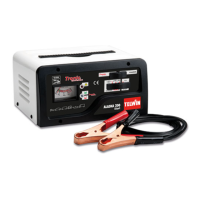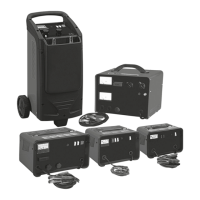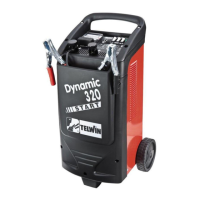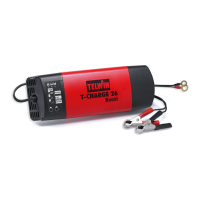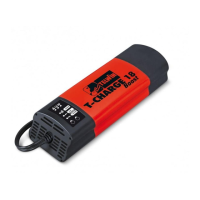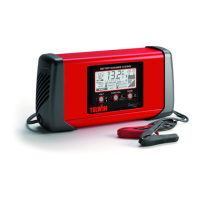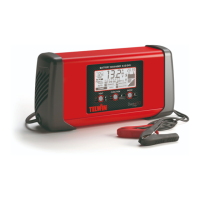the display will show the message “END”. seriously damage the battery or even the electrical and
electronic equipment in the vehicle.
Simultaneous charging of more than one battery (FIG. - It is absolutely necessary to allow the starting phase
D) of the battery charger, indicated by “RUN” on the
Take very great care when carrying out this type of
display, to conclude even if the vehicle engine does
operation: WARNING; do not carry out simultaneous
not start to turn.
_________________________________________________________________________________
charging of batteries of different capacities or types, or if
their charge conditions differ.
WARNING:
Batteries that are to be charged simultaneously can be
This battery charger/starter is a microprocessor-controlled
connected in “series” or in “parallel”. Of the two systems, we
electronic appliance that is able to protect the vehicle
recommend connecting in series because in this way it is
electronics from overvoltage that may be generated when
possible to monitor the current circulating in each battery,
charging particularly flat or sulphated batteries. In this case
which will be the same as that shown by the ammeter.
the protective capacity is demonstrated by blocking the
charge function every time the “ON” key is pressed: just a
NOTE: If two batteries with rated voltages of 12V are
fraction of a second is needed to evaluate the condition of
connected in series, the battery charger MUST be set to the
the battery and automatically interrupt charging on detection
24V position.
of overvoltage risks that are a danger to vehicle appliances
which are connected electrically to the battery terminals.
END OF CHARGING
WARNING: select the charge voltage to match the rated
-It is possible to END charging by pressing the “OFF” key or
voltage of the battery to be charged.
else the battery charger can be left to switch itself
automatically to “OFF” when the time runs out.
CHARGING VERY FLAT OR SULPHATED BATTERIES
-Disconnect the power supply to the battery charger by
WARNING: under these charge conditions the vehicle
removing the power supply cable from the mains socket.
electronics is not protected, therefore it is absolutely
-Disconnect the black charge clamp from the vehicle chassis
necessary to disconnect the battery from the vehicle.
or from the negative terminal of the battery (- symbol).
To be able to charge such batteries it is necessary to
-Disconnect the red charge clamp from the positive terminal
override the intrinsic property of the battery charger, which
of the battery (+ symbol).
provides protection against overvoltage that could destroy
-Store the battery charger in a dry place.
the vehicle electronics.
-Close the battery cells using the appropriate caps (if
present).
The user has the possibility of totally or partially removing
these safeguards (3 protection LEVELS) by adopting the
STARTING
following procedure:
Press the corresponding key to pass to “START” mode.
- In “TEST” mode press the “I / V / TIME” key for about 4
For starting set up the battery charger in the start position at
seconds until the current display disappears and either
the correct voltage.
“L1”, “L2” or “L3” is displayed.
Within this mode the status of the charger is one of three
- Press the “HOURS” key to select the desired protection
types:
level:
- Pause status, countdown lasting "40 seconds"
“L1” = maximum protection with detection of connection
- Waiting for user to start status, “GO”;
and/or setting error enabled and limitation of actual
- Starting status “4 seconds”.
charge enabled;
NOTE: For further details about the indicator see FIG. B.
“L2” = intermediate protection with only detection of
Before turning the starter key, it is essential to make a
connection and/or setting error enabled, overvoltage and
rapid charge of 5-10 minutes, which will greatly facilitate
ripple protection enabled;
starting.
“L3” = all safeguards disabled.
Rapid charge should be carried out only and exclusively
- Save the choice of protection level by pressing the “I / V /
with the battery charger in charge mode and not in start
TIME” key for about 4 seconds.
mode.
Every time the battery charger is switched on it
If no alarms of any type have triggered, you may
automatically returns to the maximum protection level
proceed as follows.
“L1”.
Before starting the vehicle, make sure the battery
terminal is properly connected to the respective clamps
STARTING VERY FLAT OR SULPHATED BATTERIES
(“+” and “-”) and that the battery is in good condition
(NOT RECOMMENDED)
(not sulphated or failed).
To be able to start potentially sulphated or very flat
Never ever start vehicles with the battery terminals
batteries it may be necessary to start the vehicle
disconnected from their respective clamps; the
without the support of the electronic safeguards (NOT
presence of the battery is essential for eliminating any
RECOMMENDED). In any case, in order to prevent
possible overvoltage that could be generated by the
damage to on-board electronics (a possibility with
energy accumulating in the connecting cables during
sulphated or very flat batteries) it is NECESSARY to
the starting phase.
allow the starter to conclude the 4-second start cycle
Failure to observe these instructions may damage the
even if the vehicle engine does not start to turn.
vehicle electronics.
_________________________________________________________________________________
7. SAFEGUARDS (FIG. E)
The battery charger is fitted with safeguards that trigger in
the case of:
WARNING:
- over-charging (excess current output to the battery);
- Before proceeding further read the vehicle manufacturer's
- overvoltage (battery or instant charging voltage too high);
instructions carefully.
- short circuit (charge clamps in contact with one another);
- Ensure that the power supply line is protected by fuses or
- reverse polarity on battery terminals;
automatic switches with a capacity corresponding to that
shown on the rating plate with the symbol ( ).
If it is necessary to replace the fuses in appliances fitted with
- To prevent overheating in the battery charger, carry out
them, use compatible replacements with the same rated
the starting operation keeping STRICTLY to the
current value.
work/pause cycles indicated on the appliance. Do not
insist further if the vehicle engine does not start: this could
- 4 -

